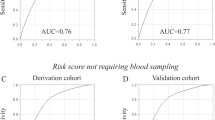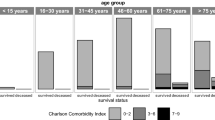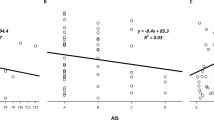Abstract
It has been reported that since 1982 the incidence in persons with spinal cord injury (SCI) of hypertension is commoner than it is in the general population of the same age groups in Japan. In the current study, we examined outpatient morbidity rates and standardised outpatient morbidity ratios (SOMR) according to the site of injury, as well as blood pressure levels and history of disease, and compared the incidences with those for the general population. The subjects consisted of 195 men with SCI. All were engaged in light work at special centres while living with other persons at the centres. The mean age was 49.5 years old, and the average post-injury period was 17.9 years. With respect to the site of injury, 19 patients had had injuries at the level of C-T5, 24 at T6-T10, 139 at T11-L1, and 13 at L2 or lower. The SOMR (general population = 100) for hypertension was closely related to the site of injury, i.e. 0 at C-T5, 250 at T6-T10, 221 at T11-L1 and 308 at L2 or below. Among the patients treated with antihypertensive agents (41 persons), 17.1% were under treatment for renal diseases, 4.9% for diabetes, and 4.9% for hepatic disorders. In 68% of the SCI persons examined, however no disease (such as renal disease, diabetes mellitus, hepatic disease or endocrine abnormality) could be regarded as a cause of secondary hypertension. In addition, the survey revealed that the body weight of SCI persons was lower than that of the general populations.
Similar content being viewed by others

Log in or create a free account to read this content
Gain free access to this article, as well as selected content from this journal and more on nature.com
or
References
DeVivo M J, Stover S L, Black K J (1992) Prognostic factors for 12-year survival after spinal cord injury. Arch Phys Med Rehabil 73: 156–162.
Whiteneck G G, Charlifue S W, Frankel H L et al 1992 Mortality, morbidity, and psychosocial outcomes of persons spinal cord injured more than 20 years age. Paraplegia 30: 617–630.
Lang H D, Durr W, Hoffman J, Koeth R (1980) Post-clinical follow-up of spinal patients through domestic check-ups. Paraplegia 18: 140–141.
Yekutiel M, Brooks M E, Ohry A, Yarom J, Carel R (1989) The prevalence of hypertension, ischemic heart disease and diabetes in traumatic spinal cord injured patients and amputees, Paraplegia 27: 58–62.
Sakai M, Yoshida I, Itoh F et al 1988 Aging in persons with spinal cord injuries. JJTOM 31: 659–663 (in Japanese).
Nakajima A, Honda S, Yoshimura S et al 1989 The disease pattern and causes of death of spinal cord injured patients in Japan. Paraplegia 27: 163–171.
Kadowaki T (1982) Status of health in persons with traumatic spinal cord lesion. JJTOM 30: 805–815 (in Japanese).
Nakajima A, Yoshida I, Itoh F et al (1982) Aging in persons with spinal cord injuries. JJTOM 30: 536–540 (in Japanese).
Imai K, Kadowaki T, Takata T, Fukutomi K . (1993) Comparison of diseases prevalence between spinal cord injury persons and the general population. J Jpn Med Soc Paraplegia 5: 140–141 (in Japanese).
Statistics and Information Department, Minister's Secretariat, Ministry of Health and Welfare (1989) National Livelihood Basic Survey. Tokyo.
Health Service Bureau, Ministry of Health and Welfare (1993) 1991 National Nutrition Survey. Tokyo.
Braddom R L, Rocco J F (1991) Autonomic dysreflexia. A survey of current treatment. Am J Phys Med Rehabil 70: 234–241.
Lindan R, Joiner E, Freehafer A A, Hazel C (1980) Autonomic dysreflexia in patients with spinal cord injury. Paraplegia, 18; 285–292.
Killorin W, Gray M, Bennett J K, Green B G (1992) The value of urodynamics and bladder management in predicting upper urinary tract complications in male spinal cord injury patients. Paraplegia 30: 437–441.
Stover S L, Lloyd L K, Waites K B, Jackson A B (1991) Neurogenic urinary tract infection. Neurogen Clin 9: 741–755.
Hoffberg H J, Cardenas D D (1986) Bladder trabeculation in spinal cord injury. Arch Phys Med Rehabil 67: 750–753.
Vaziri N D, Gordon S, Nikakhtar B (1982) Lipid abnormalities in chronic renal failure associated with spinal cord injury. Paraplegia 20: 183–189.
Duckworth W C, Jallepalli P, Solomon S S (1983) Glucose intolerance in spinal cord injury, Arch Phys Med Rehabil 64: 107–110.
Duckworth W C, Solomon S, Jallepalli P et al 1980 Glucose intolerance due to insulin resistance in patients with spinal cord injuries. Diabetes 29: 906–910.
Bauman W A, Spungen A M, Raza M et al (1992) Coronary artery disease: Metabolic risk factors and latent disease in individuals with paraplegia. Mt Sinai J Med 59: 163–168.
Kuhlemeier K V, McEachran A B, Lloyd L K (1984) Serum creatinine as an indicator of renal function after spinal cord injury. Arch Phys Med Rehabil 65: 694–697.
Mirahmadi M K, Byrne C, Barton C (1983) Prediction of creatinine clearance from serum creatinine in spinal cord injury patients. Paraplegia 21: 23–29.
Krum H, Howes L G, Brown D J et al (1992) Risk factors for cardiovascular disease in chronic spinal cord injury patients. Paraplegia 30: 381–388.
Bauman W A, Spungen A M, Zhong Y G et al 1992 Depressed serum high density lipoprotein cholesterol levels in veterans with spinal cord injury. Paraplegia 30: 697–703.
Cardus D, Ribas-Cardus F, McTaggart W G (1992) Lipid profiles in spinal cord injury. Paraplegia 30: 775–782.
Cardis D, Ribas-Cards F, McTagget W G (1992) Coronary risk in spinal cord injury: Assessment following a multivariate approach. Arch Phys Med Rehabil 73: 930–933.
Brenes G, Dearwater S, Shapera R (1986) High density lipoprotein cholesterol concentrations in physically active and sedentary spinal cord injured patients. Arch Phys Med Rehabil 67: 445–450.
Kadowaki T, Imai K, Fukutomi K et al 1991 Cornal Medical Index analysis of subjective symptoms in persons with traumatic spinal cord injury. JJTOM 39: 272–279.
Palmer J B (1985) Depression and adrenocortical function in spinal cord injury patients. Arch Phys Med Rehabil 66: 253–256.
Author information
Authors and Affiliations
Rights and permissions
About this article
Cite this article
Imai, K., Kadowaki, T., Aizawa, Y. et al. Morbidity rates of complications in persons with spinal cord injury according to the site of injury and with special reference to hypertension. Spinal Cord 32, 246–252 (1994). https://doi.org/10.1038/sc.1994.44
Issue date:
DOI: https://doi.org/10.1038/sc.1994.44
Keywords
This article is cited by
-
Baroreceptor sensitivity response to phase IV of the Valsalva maneuver in spinal cord injury
Clinical Autonomic Research (1998)


